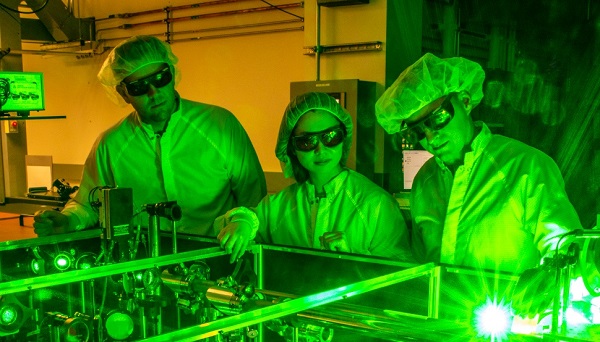The Berkeley Lab Laser Accelerator (BELLA) Center at the U.S. Department of Energy’s Lawrence Berkeley National Laboratory has developed and tested an optical system to precisely measure and control the position and pointing angle of high-power laser beams with unprecedented accuracy, and without interrupting or disturbing the beams.
Highly demanding laser applications require high levels of precision; laser beams move around at a tiny scale in response to the vibrations and variability of even the most controlled laboratory environment. “Missing the target by as little as a few microns can make the difference between amazing science and an unwanted addition to background noise,” said Fumika Isono, a doctoral candidate at the University of California, Berkeley and the first author of the researchers’ paper.

Berkeley Lab doctoral student Fumika Isono (center), BELLA Center Deputy Director Jeroen van Tilborg (right), and research scientist Sam Barber set up a novel laser stabilization experiment at one of the BELLA Center’s 100-TW-class lasers. Courtesy of Marilyn Sargent/Berkeley Lab.
Additionally, pointing angle offsets of less than a thousandth of a degree can result in unwanted complexities.
Traditional approaches to measure these parameters accurately and without intercepting the beam either greatly sap the power of the beam by intercepting its pulses or suffer inaccuracies because they are not measuring the beam exactly as delivered.
The approach developed at the BELLA Center involves splitting off and monitoring a low-powered exact copy of the main beam, reflected from the rear surface of a specially designed final optic in the beam line.
The heart of the approach is a laser architecture with three key attributes. First, it simultaneously provides five high-powered pulses and a thousand low-powered pulses per second. These pulses all follow the same path. Second, the beamline is optimized to keep the high- and low-powered pulses matched in size and divergence.
Finally, the approach replaces one of the reflective beam line mirrors with an innovative wedge-shape reflector with specialty coatings on both the front and rear surfaces (described in the paper as “double-surface-coated”).
Almost all of the main beam is reflected off the front surface of the optic without otherwise being noticeably affected. A small portion called the “witness beam,” which represents approximately 1% of the input power, propagates through the front surface and is reflected off the rear surface. The witness beam goes through any subsequent optics almost in parallel to the main beam, with just enough diversion for easy placement of measurement instruments.
The end result is a witness beam with pointing angle and transverse position highly correlated to that of the main beam.

The research team hopes to use the diagnostic as part of a feedback system for active stabilization of the laser’s transverse position and pointing angle. Preliminary studies with the 100-TW laser at BELLA have been promising, the team reported. According to the work, it’s possible to remove shake from the high-power 5-Hz laser by actively stabilizing the low-power 1-kHz laser pulse train. Laser beam vibration and motion were observed to occur on a scale of a few tens of hertz, which is within the range of a practical feedback system. The team expects a fivefold improvement in position and angle of high-power laser pulse delivery.
High-Power Potential
A near-future goal, the researchers said, is to use is the diagnostic as part of a feedback system for active stabilization of the laser’s transverse position and pointing angle; preliminary studies with the 100-TW laser at BELLA Center have been promising, they report. Their paper introduces the prospect of removing the jitters on the high-power 5-Hz laser by actively stabilizing the low-power 1-kHz laser pulse train.
The development of laser-plasma particle accelerators (LPAs), which is the primary mission of the BELLA Center, exemplifies the potential benefit of this innovation. LPAs produce ultrahigh electric fields that accelerate charged particles very rapidly, thereby offering the promise of a next generation of more compact, more affordable accelerators for a wide variety of applications.
Since LPAs perform their acceleration within a thin hollow tube or “capillary,” they would benefit greatly from improved control of the drive laser beam position and pointing angle.
One immediate application at the BELLA Center is the use of an LPA to provide electron beams for a free-electron laser (FEL) — a device that produces bright photon pulses at a far higher energy and shorter wavelength than visible light.
“The undulator, the magnetic array at the heart of the FEL, has very strict requirements on electron beam acceptance, which directly relates to the LPA drive laser pointing angle and transverse fluctuations,” Isono said.
The proposed kBELLA, a next-generation laser system that will combine high power with a kilohertz repetition rate, will be another likely application.
“This work is not limited to laser-plasma acceleration,” said BELLA Center Director Eric Esarey. “It addresses a specific need throughout the high-power laser community, namely, proving a correlated low-power copy of the high-power pulse without significant interference. Anywhere a high-power laser beam needs to be delivered with some precision to any application, this diagnostic is going to make a big difference. Think of laser-particle collision experiments, or laser interactions with micron-precision targets such as capillaries or droplets.”
The work was supported by the DOE Office of Science, the Office of Basic Energy Sciences, the Office of High Energy Physics, and the Gordon and Betty Moore Foundation.
The research was published in High Power Laser Science and Engineering (www.doi.org/10.1017/hpl.2021.12).